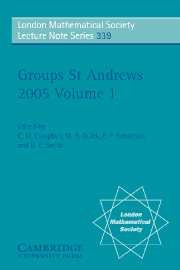Book contents
- Frontmatter
- Contents
- Introduction
- Aspects of infinite permutation groups
- Self-similarity and branching in group theory
- On surface groups: motivating examples in combinatorial group theory
- Nilpotent p-algebras and factorized p-groups
- Classification of finite groups by the number of element centralizers
- Algorithmic use of the Mal'cev correspondence
- Minimal but inefficient presentations for semi-direct products of finite cyclic monoids
- The modular isomorphism problem for finite p-groups with a cyclic subgroup of index p2
- On one-generated formations
- New results on products of finite groups
- Radical locally finite T-groups
- Explicit tilting complexes for the Broué conjecture on 3-blocks
- Conjugacy classes of p-regular elements in p-solvable groups
- An algorithm for the unit group of the Burnside ring of a finite group
- Integral group ring of the first Mathieu simple group
- Embedding properties in direct products
- Malcev presentations for subsemigroups of groups — a survey
- Finite groups with extremal conditions on sizes of conjugacy classes and on degrees of irreducible characters
- Conjugacy class structure in simple algebraic groups
- On automorphisms of products of groups
- Linear groups with infinite central dimension
- G-automata, counter languages and the Chomsky hierarchy
- An embedding theorem for groups universally equivalent to free nilpotent groups
- Irreducible word problems in groups
- Recent growth results
Embedding properties in direct products
Published online by Cambridge University Press: 07 May 2010
- Frontmatter
- Contents
- Introduction
- Aspects of infinite permutation groups
- Self-similarity and branching in group theory
- On surface groups: motivating examples in combinatorial group theory
- Nilpotent p-algebras and factorized p-groups
- Classification of finite groups by the number of element centralizers
- Algorithmic use of the Mal'cev correspondence
- Minimal but inefficient presentations for semi-direct products of finite cyclic monoids
- The modular isomorphism problem for finite p-groups with a cyclic subgroup of index p2
- On one-generated formations
- New results on products of finite groups
- Radical locally finite T-groups
- Explicit tilting complexes for the Broué conjecture on 3-blocks
- Conjugacy classes of p-regular elements in p-solvable groups
- An algorithm for the unit group of the Burnside ring of a finite group
- Integral group ring of the first Mathieu simple group
- Embedding properties in direct products
- Malcev presentations for subsemigroups of groups — a survey
- Finite groups with extremal conditions on sizes of conjugacy classes and on degrees of irreducible characters
- Conjugacy class structure in simple algebraic groups
- On automorphisms of products of groups
- Linear groups with infinite central dimension
- G-automata, counter languages and the Chomsky hierarchy
- An embedding theorem for groups universally equivalent to free nilpotent groups
- Irreducible word problems in groups
- Recent growth results
Summary
Introduction
This paper is a survey article containing an up-to-date account of recent achievements regarding embedding properties in direct products of groups. In the last years, several authors are carrying out a systematic study with the aim of understanding how subgroups with various embedding properties can be detected and characterized in the subgroup lattice of a direct product of two groups in terms of the subgroup lattices of the two groups.
Unless otherwise stated all groups considered in this paper are finite.
Direct products are maybe the easiest way to construct new groups from given ones and in spite of the simplicity of this construction, their structures are sometimes surprising.
The subgroup structure of direct products is well-known by a classical result due to Goursat. In this paper G1 × G2 = {(g1, g2) | gi ∈ Gi, i = 1, 2} will always denote the direct product of the groups G1 and G2 and πi will denote the canonical projection πi : G1 × G2 → Gi, for i = 1, 2. For a subgroup U of G1 × G2:
πi (U) = UGj ∩ Gi, {i, j} = {1, 2},
U ∩ Gi ⊴ πi (U), for i = 1, 2.
Goursat's theorem states that, apart from the direct product of subgroups of the direct factors, only ‘diagonal’ subgroups appear in a direct product.
- Type
- Chapter
- Information
- Groups St Andrews 2005 , pp. 246 - 255Publisher: Cambridge University PressPrint publication year: 2007

